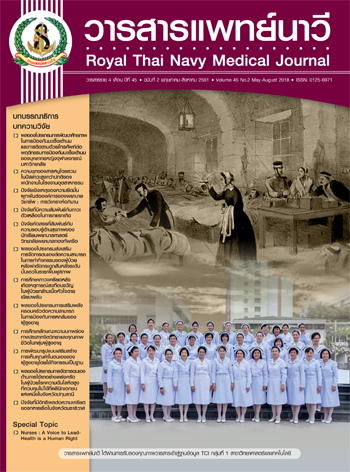Development of the Self-Esteem Enhancement Model for Older Adults with Activity-Based Learning
Main Article Content
Abstract
This development research aimed to develop a self-esteem enhancement model for older adults using Activity-Based Learning. This study was divided into 3 phases as follows: (1) Phase one was concerned with the analysis and synthesis of basic information related to theories of ageing, the needs of education, geragogy, activity theory and the concept of contemplative education. In-depth interviews were conducted with regarding in aging society and high self-esteem characteristics, regarding the processes of organizing activities for the elderly and contextual education. All of these factors were developed via model drafting; (2) In phase two: a draft of the self-esteem enhancement model for older adults was developed. The main components were defined, as follows: the principles of the model, the objectives of the model, the processes of the model, and the evaluation process. The quality of the model was checked with an appropriate evaluation form, assessed in terms of consistency and
feasibility by 5 experts. The data analysis use mean and standard eviation. The instruments were as 1) self-esteem assessment form and 2) self-esteem behavior observation form. The data were analyzed by mean, standard deviation and reliability with a Cronbach’s alpha was 0.92.; (3) In phase three: the effectiveness of the self-esteem enhancement model for the older adults were evaluated. There were 30 participants, classified into the inclusion criteria by simple randomized sampling. The duration of the experiment was twelve weeks. The data were analyzed by t-test and One-way repeated measures ANOVA.
The finding were as follows:
1) The self-esteem enhancement model for the older adults with activity based learning were appropriate consistent with high level.
2) The mean scores of self-esteem after the experiment was significantly higher than before the experiment (p < .05) and the mean scores of self-esteem were significantly difference in periods of time at least one (p < .05).
Article Details

This work is licensed under a Creative Commons Attribution-NonCommercial-NoDerivatives 4.0 International License.
References
Maslow AH. A theory of human motivation. Psychological Review 1943;50(4):370-94
California State Department of Education. Toward a state of esteem: the final report of the California task force to promote self-esteem and personal and social responsibility. California: California office of State Printing; 1990
Ranzijn R, Keeves J, Luszcz M, Feather NT. The role of self-perceived usefulness and competence in the self-esteem of elderly adults: confirmatory factor analyses of the bachman revision of Rosenberg’s Self-Esteem Scale. J Gerontol B Psychol Sci Soc Sci 1998;53(2):96-104
Veenhoven R. Quality of life in individualistic society: a comparison of 43 nations in the early 1990’s. Social Indicators Research 1999;48(1):157-86
Diener E, Biswas Diener R. Happiness: unlocking the mysteries of psychological. Oxford: Wealth Blackwell; 2008
Deaton A. The great escape: health, wealth, and the origins of inequality. Princeton, NJ: Princeton University Press; 2013
Sivapuchpong N. Internal and external factors correlated to quality of life of the elders in Bangkok and provincial areas. [Master’s Thesis, Faculty of Education]. Srinakharinwirot University; 2011. (in Thai)
Kulprasutidilok A, Jirawongnusorn S, Chitmanasak N, Supawantanakul D. Path analysis of factors affecting quality of life in the elderly in Bang Khen district, Bangkok. Journal of Health Science Research 2014;8(2):35-46. (in Thai)
Sajjasophon R. Educational concepts for developing active aging in the elderly. Kasetsart J (Soc. Sci) 2013;34(3):471-90. (in Thai)
Havinghurst RJ, Neugarten BL, Tobin SS. Disengagement and patterns of aging. In Neugarten BL, editor. Middle age and aging: a reader in social psychology. Chicago: The University of Chicago Press; 1968
มูลนิธิสถาบันวิจัยและพัฒนาผู้สูงอายุไทย. รายงานสถานการณ์ผู้สูงอายุไทย พ.ศ. 2559. นครปฐม: พริ้นทอรี่; 2560
Charoensuk D. Contemporary aging and community health promotion. JOPN 2015;7(2):280-95. (in Thai)
Orth U, Robins RW, Widaman KF. Life-span development of self-esteem and its effects on important life outcomes. J Pers Soc Psychol 2012;102(6):1271-88
Chung JM, Robins RW, Trzesniewski KH, Noftle EE, Roberts BW, Widaman KF. Continuity and change in self-esteem during emerging adulthood. J Pers Soc Psychol 2014;106(3):469-83
Amatyakul K. Development of a Lifelong learning model based on neo-humanist concepts for sustainable human and society development. Journal of Education Studies 2012;40(1):202-17. (in Thai)
McClusky HY. The community of generations: a goal and a context for the education of persons in the later years. In Sherron RH, Lumsden DB, editors. Introduction to educational gerontology. 3rd edition. New York: CRC Press; 1975. p. 59-84
Ratna-Ubol A, Pathumcharoenwattana W, Pathumcharoenwattana W, Kimpee P, Sajjasophon R. Education and lifelong learning of Thai senior citizens. [Complete Research Report, Faculty of Eucation]. Chulalongkorn University; 2011. (in Thai)
Onsri P. Contemplative education: education for human development in 21st century. Journal of The Royal Thai Army Nurses 2014;15(1):7-11. (in Thai)
Polit DF, Beck CT. Nursing research: principle and methods. 7th editions. Philadelphia: Wolters Klower/Lippincott Williams & Wilkins; 2004.
วิชัย วงษ์ใหญ่. หลักสูตรการศึกษากับการพัฒนาประเทศ. สารานุกรม 60 ปี 60 คำ ศรีนครินทรวิโรฒ. กรุงเทพมหานคร: คณะศิลปกรรมศาสตร์ มหาวิทยาลัยศรีนครินทรวิโรฒ; 2554. หน้า 415-20
วิจารณ์ พานิช. เรียนรู้สู่การเปลี่ยนแปลง. กรุงเทพมหานคร: เอส. อาร์.พริ้นติ้ง แมสโปรดักส์; 2558
Palmer PJ. Let your life speak: listening for the voice of vacation. San Francisco: John Willey & Sons; 2000
McMillan DW, Chavis DM. Sense of community: a definition and theory. American Journal of Community Psychology 1986;14(1):6-23
Prochaska JO, Velicer WF, Rossi JS, Goldstein MG, Marcus BH, Rakowski W, et al. Stage of change and decision balance for 12 problem behaviors. Health Psychol 1994;13(1):39-46

